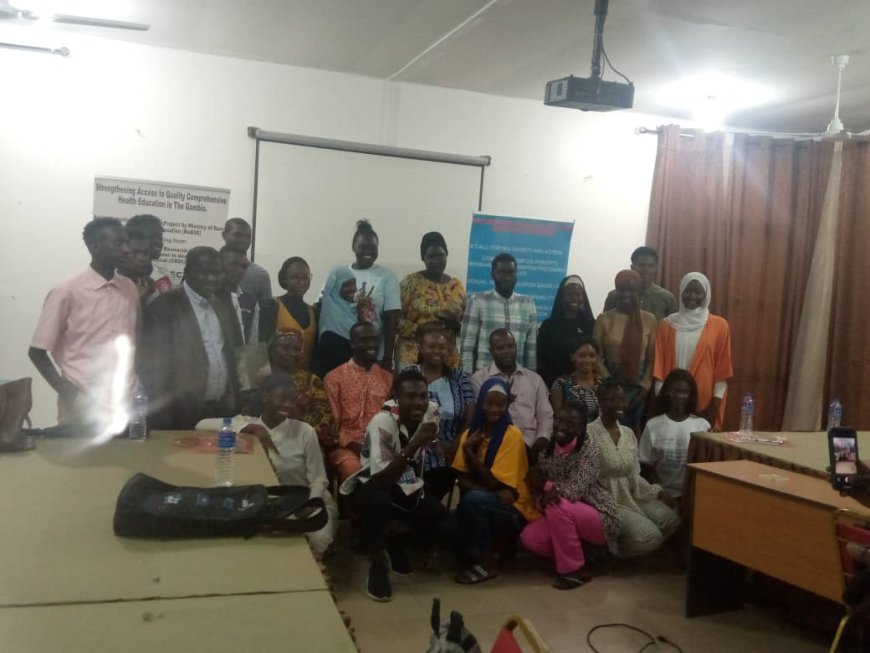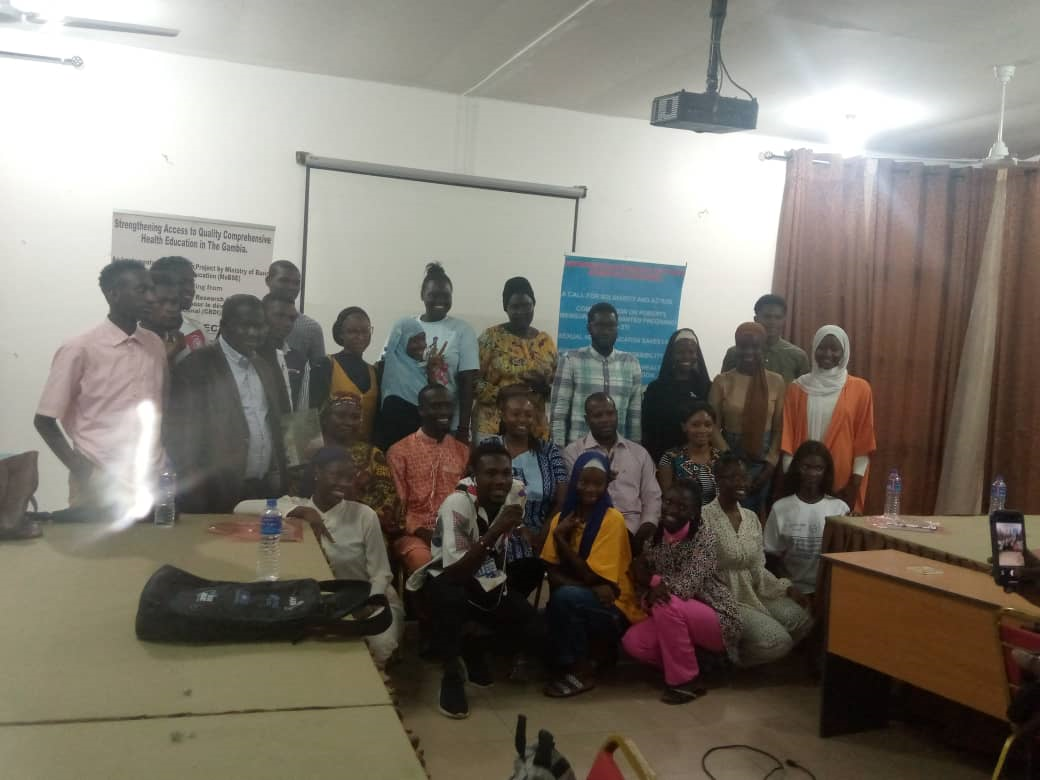CHE Principal Investigator discusses challenges affecting sexual and reproductive health of adolescents –
CHE Principal Investigator discusses challenges affecting sexual and reproductive health of adolescents Voice Gambia Newspaper

Challenges Affecting Programs on Sexual Reproductive Health of Adolescents in The Gambia
By Binta Jaiteh

Phebian Ina Grant-Sagnia, Principal investigator for the Comprehensive Health Education project, presented a detailed report on the challenges affecting programs on sexual reproductive health of adolescents in The Gambia. The report is based on a five-year Implementation Research Project conducted by the Ministry of Basic and Secondary Education (MOBSE) with funding from the International Development Research Centre (IDRC)/Centre de Recherches Pour le Dévelopment International (CRDI).
Despite numerous efforts and policy frameworks to improve the sexual and reproductive health of young people, adolescents aged 15-24, who make up 32% of the population in The Gambia, still lack access to quality education, information, and services for preventing and protecting themselves against sexual and reproductive health problems.
The main challenges identified for adolescents regarding sexual reproductive health include limited coordination across various implementing agencies of sexual and reproductive health programs and funding gaps for such programs. Additionally, policy restrictions and societal norms that perceive discussions on sexual and reproductive health issues as highly culturally sensitive contribute to these challenges.
In the early 1990s, Comprehensive Health Education (CHE) programs were introduced in schools in The Gambia to address issues such as high population growth rate, adolescent pregnancy and illegal abortion, drug abuse, high infant and maternal mortality rates, Sexually Transmitted Infections (STIs), HIV/AIDS, and environmental degradation. The school curriculum, with support from UNFPA, has been utilized for these programs.
However, concerns about adolescent sexual and reproductive health (ASRH) have grown in recent years due to increasing rates of sexual and reproductive health infections, early sexual debut, and teenage and unwanted pregnancies. Of particular concern is the high prevalence of teenage pregnancies outside of marriage among adolescent girls in The Gambia, where almost one in five (18%) of adolescent women aged 15 to 19 are already mothers or pregnant with their first child (GDHS, 2013).
This study aims to address the weaknesses and gaps in knowledge and practices related to ASRH. It also aims to provide policymakers at the Ministry of Basic and Secondary Education with detailed information on the type and short-term effects of age-appropriate and culturally relevant interventions that can be scaled up to strengthen access to quality comprehensive sexuality education. The goal is to meet the sexual and reproductive health rights and needs of adolescents and youth in all regions of The Gambia.
SDGs, Targets, and Indicators
-
SDG 3: Good Health and Well-being
- Target 3.7: By 2030, ensure universal access to sexual and reproductive health-care services, including for family planning, information and education, and the integration of reproductive health into national strategies and programs.
- Indicator 3.7.1: Proportion of women of reproductive age (aged 15-49 years) who have their need for family planning satisfied with modern methods.
- Indicator 3.7.2: Adolescent birth rate (aged 10-14 years; aged 15-19 years) per 1,000 women in that age group.
-
SDG 4: Quality Education
- Target 4.7: By 2030, ensure that all learners acquire the knowledge and skills needed to promote sustainable development, including, among others, through education for sustainable development and sustainable lifestyles, human rights, gender equality, promotion of a culture of peace and non-violence, global citizenship, and appreciation of cultural diversity and of culture’s contribution to sustainable development.
- Indicator 4.7.1: Extent to which (i) global citizenship education and (ii) education for sustainable development (including climate change education) are mainstreamed in (a) national education policies; (b) curricula; (c) teacher education; and (d) student assessment.
Table: SDGs, Targets, and Indicators
| SDGs | Targets | Indicators |
|---|---|---|
| SDG 3: Good Health and Well-being | Target 3.7: By 2030, ensure universal access to sexual and reproductive health-care services, including for family planning, information and education, and the integration of reproductive health into national strategies and programs. | Indicator 3.7.1: Proportion of women of reproductive age (aged 15-49 years) who have their need for family planning satisfied with modern methods. Indicator 3.7.2: Adolescent birth rate (aged 10-14 years; aged 15-19 years) per 1,000 women in that age group. |
| SDG 4: Quality Education | Target 4.7: By 2030, ensure that all learners acquire the knowledge and skills needed to promote sustainable development, including, among others, through education for sustainable development and sustainable lifestyles, human rights, gender equality, promotion of a culture of peace and non-violence, global citizenship, and appreciation of cultural diversity and of culture’s contribution to sustainable development. | Indicator 4.7.1: Extent to which (i) global citizenship education and (ii) education for sustainable development (including climate change education) are mainstreamed in (a) national education policies; (b) curricula; (c) teacher education; and (d) student assessment. |
Analysis
The issues highlighted in the article are connected to SDG 3: Good Health and Well-being and SDG 4: Quality Education.
SDG 3: Good Health and Well-being
The article discusses the challenges affecting programs on Sexual Reproductive Health (SRH) of adolescents in The Gambia. It mentions that adolescents lack access to quality education, information, and services on preventing and protecting themselves against sexual and reproductive health problems. This aligns with SDG 3’s target of ensuring universal access to sexual and reproductive health-care services, including for family planning, information, and education. The indicators mentioned in the article that can measure progress towards this target are Indicator 3.7.1 (proportion of women of reproductive age who have their need for family planning satisfied with modern methods) and Indicator 3.7.2 (adolescent birth rate).
SDG 4: Quality Education
The article highlights the Comprehensive Health Education (CHE) programs in schools in The Gambia, which aim to address issues such as high population growth rate, adolescent pregnancy, illegal abortion, drug abuse, high infant and maternal mortality rates, sexually transmitted infections (STIs), HIV/AIDS, and environmental degradation. These programs align with SDG 4’s target of ensuring that all learners acquire the knowledge and skills needed to promote sustainable development. The indicator mentioned in the article that can measure progress towards this target is Indicator 4.7.1 (extent to which global citizenship education and education for sustainable development are mainstreamed in national education policies, curricula, teacher education, and student assessment).
Behold! This splendid article springs forth from the wellspring of knowledge, shaped by a wondrous proprietary AI technology that delved into a vast ocean of data, illuminating the path towards the Sustainable Development Goals. Remember that all rights are reserved by SDG Investors LLC, empowering us to champion progress together.
Source: voicegambia.com

Join us, as fellow seekers of change, on a transformative journey at https://sdgtalks.ai/welcome, where you can become a member and actively contribute to shaping a brighter future.







